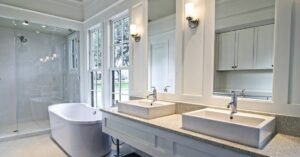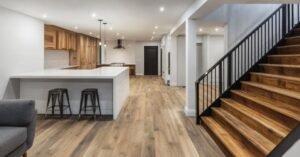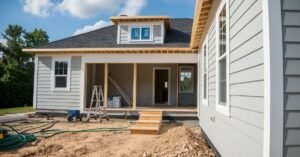A basement remodel can breathe new life into your home, but it’s important to approach it creatively and practically.
Before you start picking out paint colors or flooring options, it’s important to understand the financial impact of each decision you make throughout the process.
In this guide, we’ll walk you through the average costs, potential hidden expenses, and factors that will influence your budget so you can be prepared for the final bill.
Average Cost of a Basement Remodel in Naperville, IL
The cost of a basement remodel in Naperville typically ranges from $20,000 to $50,000 for a mid-range renovation. This includes essentials like drywall, flooring, lighting, painting, and basic plumbing or electrical work.
However, more extensive remodels with high-end finishes, custom features, or major structural changes can exceed $75,000.
It’s important to note that furnishings, appliances, and décor are additional expenses that are not typically included in base remodeling quotes.
These can significantly impact your final budget, especially if you’re adding elements such as a home theater system, wet bar, bathroom, or kitchen.
Factors That Influence the Total Cost
Setting a firm budget for a basement remodel is essential, as costs can quickly escalate depending on the project’s complexity. From waterproofing and structural changes to flooring and lighting, each component adds to the total price.
Understanding these factors helps homeowners make informed decisions, prioritize essential upgrades, and avoid unexpected expenses.
Waterproofing
Proper waterproofing is essential to prevent moisture issues, mold growth, and structural damage. Costs vary depending on whether minor sealing, sump pump installation, or full-scale drainage systems are needed.
Neglecting this step can lead to future costly repairs. A well-sealed basement ensures longevity and protects flooring, walls, and furniture from water damage.
Basement Size
Larger basements naturally cost more to remodel due to increased material and labor needs. More square footage means higher expenses for drywall, flooring, insulation, and paint. Additionally, bigger spaces may require extra lighting, HVAC modifications, and electrical work.
While a small basement can be transformed for a modest budget, a larger remodel can quickly push costs toward the higher end of the $20,000–$50,000 range or beyond.
Structural Changes Required
Altering the basement’s layout—such as removing or adding walls, reinforcing the foundation, or relocating staircases—can significantly impact costs.
Structural modifications often require professional engineering assessments and permits, adding to labor and material expenses. If load-bearing walls need adjustment, expect even higher costs due to additional support requirements.
Desired Features and Functionality
The cost of a basement remodel depends heavily on its intended use. Basic renovations for a storage or laundry space are relatively inexpensive while adding a home theater, wet bar, or extra bedroom increases costs.
Features like built-in shelving, soundproofing, or a second kitchen require specialized materials and labor, driving expenses higher. Homeowners should prioritize must-have features to balance functionality and budget while still achieving their desired vision.
Electrical, Plumbing, and HVAC Work
Upgrading or installing electrical, plumbing, or HVAC systems can be one of the largest cost drivers in a basement remodel. Adding outlets, lighting, or circuits increases electrical costs, while bathrooms, wet bars, or laundry areas require extensive plumbing work.
HVAC adjustments may be needed for proper ventilation, especially if enclosing rooms. Since these involve skilled labor and permits, they can add thousands to the overall cost.
Flooring
Basement flooring choices affect both cost and durability. Waterproofing is also a factor, as basements are prone to moisture issues. Basic options like vinyl or carpet are affordable, while high-end materials like engineered wood or tile increase expenses.
Some homeowners opt for radiant heating, which adds comfort but also additional costs. Selecting a moisture-resistant, budget-friendly flooring option can help keep costs under control while ensuring longevity.
Choice of Ceiling Design
The type of ceiling chosen impacts both aesthetics and cost. Drop ceilings are budget-friendly and allow easy access to plumbing and electrical work, but they reduce ceiling height.
Drywall ceilings offer a more polished look but require more labor and may limit future maintenance access. Ceiling tiles are an affordable option and come in a huge array of styles. The choice depends on style, function, and budget constraints.
Lighting Upgrades
Lighting plays a major role in making a basement feel bright and inviting, but costs vary based on fixtures and wiring needs.
Recessed lighting is popular for its sleek look, but installation can be pricey due to additional electrical work. Pendant lights, wall sconces, and LED strips add ambiance but may require rewiring.
Painting
While painting is one of the more affordable aspects of basement remodeling, it still adds to the budget. High-quality, moisture-resistant paints are recommended to prevent mold and mildew in humid conditions.
Labor costs vary based on wall texture, ceiling height, and the number of coats needed. Lighter colors help brighten basements, reducing the need for excessive lighting, while bold accent walls can add character without significantly increasing expenses.
Materials
The materials used throughout the basement—from drywall and insulation to countertops and cabinetry—significantly impact the overall cost.
Standard drywall and basic trim are budget-friendly, but custom shelving, high-end countertops, and luxury finishes drive up expenses. Durable, moisture-resistant materials are essential in basements to prevent damage.
Unexpected Issues
Hidden problems like mold, foundation cracks, and outdated wiring can emerge during remodeling, adding unexpected expenses. Fixing these issues is essential for safety and longevity, but costs vary based on severity.
Setting aside a contingency fund of at least 10–20% helps homeowners manage unforeseen costs without derailing the remodel.
Basement Remodel Ideas To Consider
A basement remodel offers endless possibilities, transforming an underutilized space into something functional and inviting. Explore the following creative basement remodel ideas and options for personalization and enhanced functionality.
- Guest Bedroom and Bath: A comfortable bedroom with built-in storage, warm lighting, and an en-suite bathroom creates a private space for family or friends.
- Family Room: Consider built-in shelving, a fireplace for warmth, or even a small kitchenette for added convenience.
- Home Gym: Rubber flooring, wall mirrors, and proper ventilation create an ideal workout space. Consider adding a small kitchenette so hydrating drinks, healthy snacks, and smoothie ingredients are easily accessible.
- Play Room for Kids: Soft flooring, colorful walls, and built-in toy storage are essential. A chalkboard wall, climbing structure, or reading nook can add extra excitement and engagement for children.
- Man Cave: Popular additions include a bar area, a big-screen TV, gaming setups, and comfortable recliners.
- Home Office: Ensure comfort with soundproofing, ergonomic furniture, and ample lighting. Built-in bookshelves, a standing desk, or a separate meeting area can make the space even more functional.
- Laundry Room: Installing energy-efficient appliances, built-in drying racks, and plenty of counter space for folding makes the area practical.
- Game Room: Consider adding a mini fridge, snack bar, or LED lighting to enhance the experience. Soundproofing ensures noise doesn’t disrupt the rest of the house.
- Home Theater: Reclining seats, surround sound, and a projector create an authentic movie-going experience, and soundproofing, blackout curtains, and LED strip lighting add to the ambiance.
- Second Kitchen: This addition is a game-changer for entertaining guests or accommodating large families. Features like a wine fridge, double oven, or extra pantry space can make meal prep and hosting easier.
- Wet Bar: With custom cabinetry, stylish countertops, and a sink for easy cleanup, a wet bar turns your basement into an entertainment hotspot. Adding a wine rack, beverage fridge, or under-counter lighting creates a sleek and sophisticated ambiance.
How To Keep Basement Remodeling Costs to a Minimum
Remodeling your basement without overspending is possible with strategic planning and cost-conscious decisions. Follow these simple tips to stay within your budget:
- Start with a clear plan.
- Prioritize must-have features over luxury upgrades.
- Obtain multiple quotes from contractors to compare pricing.
- Choose cost-effective alternatives, such as luxury vinyl plank instead of hardwood or painted drywall instead of elaborate paneling.
- Reuse existing materials when possible—e.g., repurposing cabinets or furniture.
- DIY tasks like painting or installing trim can cut labor costs.
- Address potential issues like moisture problems early to prevent costly repairs later.
- Consider phasing the remodel—completing high-priority tasks first and adding extras over time—so you can spread out expenses without compromising quality.
Final Thoughts
A basement remodel isn’t just about adding square footage—it’s about unlocking the full potential of your home. With the right vision and planning, your basement can become one of the most valuable and enjoyable parts of your home.
Every design choice, from flooring to lighting, reflects your personality and can enhance daily life. So dream big, invest wisely, and transform that underutilized space into something truly remarkable!
Frequently Asked Questions
What’s the difference between finishing a basement and remodeling a basement?
Finishing a basement involves making it livable by adding walls, flooring, lighting, and insulation. Remodeling goes beyond this by altering the layout, adding new features, or upgrading existing elements to match specific needs, such as a home theater or extra bedroom.
Does remodeling a basement increase property value?
Yes, a remodeled basement can boost property value by adding functional living space. Features like a guest suite or home office can attract buyers. However, the return on investment depends on the quality of work, material choices, and overall market conditions.
What is the most expensive part of finishing a basement?
Structural changes, plumbing, and HVAC work tend to be the most costly aspects. Installing bathrooms or kitchens requires extensive plumbing, while HVAC adjustments ensure proper ventilation. High-end finishes like custom cabinetry, flooring, and lighting can also drive up costs.
Do you need a permit to finish a basement?
Yes, permits are typically required for basement finishing, especially for electrical, plumbing, and structural work. Permits ensure safety and code compliance. Failing to obtain one can lead to fines and problems when selling the home. Always check with local authorities before starting work.





